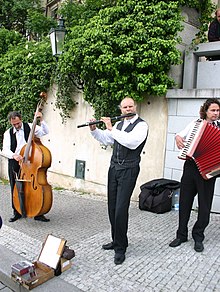polka
| polka | |
|---|---|
| Type: | Paartanz ( Society dance , folk dance ) |
| Music: | Classical , pop , folk music |
| Time signature : | 2 ⁄ 4- stroke |
| Tempo: | 27 ≈40 to 80 TPM (i.e. ≈80 to 160 bpm ) |
| Origin: | Czech Republic ( Bohemia ), Germany , Austria |
| Creation time: | around 1830 |
| List of dances | |
The polka is a lively round dance in lively to rapid two-four time or alla breve . The name comes from the Czech Republic ( Bohemia ). The basic form is a sequence of polka steps or alternating steps (short-short-long) with an emphasis on the first short step, i.e. alternating on the left and right foot. Originally, this change step was initiated with one hop in Bohemia and completed with one hop in German regions.
origin of the name
The name Polka means “Polka” in Czech and Polish. Around 1830 the dance was called půlka ("half"), the name was changed to Polka in Prague in 1835 - probably out of sympathy for the then heavily oppressed Poles (see November Uprising ), according to other information according to the Polish singer Esmeralda.
A forerunner of the polka in Czech folk dance is the "nimra".
Information from Meyers Konversationslexikon 1886
The dance is said to come from the town of Elbeteinitz ( Týnec nad Labem ), where it is said to have been invented by a Czech country girl, Anna Slezák, in 1830. Then he would have the name of his half step (step change step, Czech: půlka = half). When the polka found its way into Prague in 1835 and in Vienna and Paris in 1840 , it quickly spread across Europe . According to other sources, the story about Anna Slezák is improbable and just a widespread legend.
It is danced to very simple music in two-four time and consists of 3–4 reprises of 8, 12 or 16 bars. The movement is fairly quick, but slower than a gallop . By ballet master came - individual taking up Pas (dance steps) from other Slavonic Dances - several varieties of polka, so the hongroise polka , the mazurka (polka mazurka) , Polka à la Polacca , also of Johann Strauss apprehended Schnellpolka and others.
Origin of the dance step
The step can be traced as a hop in German folk dance long before 1800 . In 1742 Johann Sebastian Bach used a hop in his peasant cantata .
The exact form of dance is in the Rhine Franconian 1811 as Hipper handed down, even the Scottish -Rundtanz (Scottish Walzer) uses this step.
In folk dance, polka or Scottish are handed down in many countries: Austria (Krebspolka), Germany, Switzerland, the Netherlands, Denmark (Tyrolerhopsa), Sweden, Norway and of course the Czech Republic, Slovakia, Poland and many other countries.
execution
In folk dance - where the polka has been recorded since around 1835, in Austria since around 1840 - the cheerfulness of the music and the rapid rotation lead to the fact that the dancing is often quite exuberant. When ballroom dancing art, among others, is in a good dance pose .
In Austrian folk dance , there are the following distinctions:
- Polka Franze - slow (≈80 bpm ), with a hopping step after the alternating step
- Bohemian polka - a little faster (≈100 bpm), usually with a hopping step after the alternating step
- Polka - medium tempo (≈120 bpm), is danced without hops
- Schnellpolka - fast to very fast (≈160 bpm), without a hopping step
music
Well-known polka melodies include:
- Sauerkrautpolka (1961; "I like to eat sauerkraut and like to dance polka") by Gus Backus
- Tritsch-Tratsch-Polka (1858; composer: Johann Strauss (son) )
- Pizzicato polka (composers: Johann Strauss (son) and Josef Strauss )
- The clarinet Muckl , Clarinet-Polka, Opi-Polka, Polka Dziadek
- Polka de WR (Composer: Sergei Rachmaninow )
- Annemarie-Polka (composer: Herms Niel )
- Bohemian dream (composer: Norbert Gälle )
- Rosamunde (composer: Jaromír Vejvoda )
- Britta-Polka (composer: Hans Christian Lumbye )
- Ievan Polkka (composer: Eino Kettunen )
- The Pie-In-The-Face Polka (1965; from The Great Race Around the World ; composer: Henry Mancini )
- Pennsylvania Polka (from Groundhog Day ; composer: Lester Lee ; interpreter Frankie Yankovic )
- Under thunder and lightning (composer: Johann Strauss (son))
In the new folk music , polka melodies a. a. played by the folk rock band HISS .
See also
literature
- Carl Spitzweg : The inventor of the polka . In: Fliegende Blätter , Volume 1, Issue 14, 1845, p. 112 (satire)
- Constantin von Wurzbach : Slezak, Anna . In: Biographisches Lexikon des Kaiserthums Oesterreich . 35th part. Imperial-Royal Court and State Printing Office, Vienna 1877, p. 140 f. ( Digitized version ).
- Evely Fink-Mennel, Jörg Maria Ortwein (Eds.): Everything Bohemian? Musical and social aspects of the "polka" as tipsy cousin of marching music, harlequin of symphony concerts and grandmother of rock'n'roll ; Contributions to the symposium held by the Vorarlberg State Conservatory within the framework of the Lake Constance Festival 2015 and in cooperation with the ORF State Studio Vorarlberg on April 30, 2015 (= Feldkircher Musikgeschichten . Volume 4). Vorarlberger Landeskonservatorium, Feldkirch 2015, ISBN 978-3-9503243-3-4 .
Web links
- Polka dances in folk dance with description
- Polka . In: Meyers Konversations-Lexikon . 4th edition. Volume 13, Verlag des Bibliographisches Institut, Leipzig / Vienna 1885–1892, p. 188.
- Polka in the traditional dances of the county of Nice (France)
- Ennstaler Polka (with notes)
